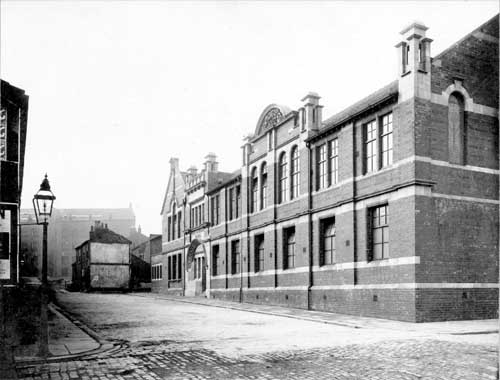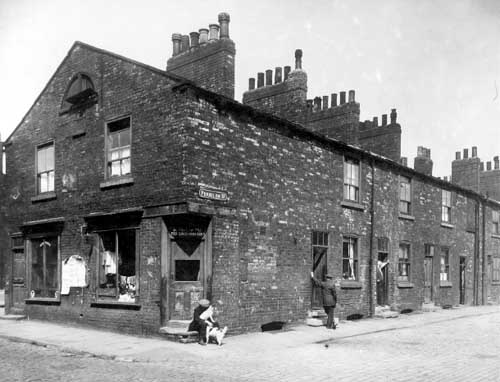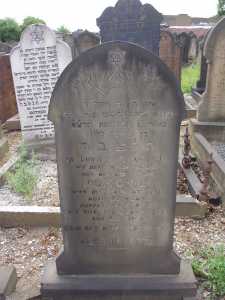My mother introduced my to genealogy way back in the 1980s and it is an interest I dip in and out of as time allows. Over the past week I have been investigating my great-grandfather, Louis Cohen (my mother’s paternal grandfather) and have been taken on a journey back to the Jewish community of Leeds (Yorkshire) in the early 20th century.

Beth Hamidrash Hagadol synagogue, Back Nile Street, Leeds, 1908 (Leeds Photographic Archive, http://www.leodis.net)
Louis was born around 1876. I have not been able to find any information about his birthplace beyond the fact that it in the part of Poland which was ruled at that time by Russia. His Hebrew name was Jehuda Ariah and he was the son of Zvi Meier Cohen. He married “Fanny” Spivock, probably around 1896. Her grave shows her Hebrew name as Esther daughter of Abraham; I can’t see how Esther could have been corrupted to Fanny, so she may have had another Polish-Russian given name. While they were still in “Russia” Louis and Fanny had two children: Isaac, born around 1897, and Nellie, born on 14th January 1900. Some time between 1900 and 1907 the family emigrated to England where they settled in the city of Leeds, where there was a rapidly growing Jewish community based mainly in the Leylands area to the north of the city. Once settled in Leeds Fanny gave birth to another six sons and two daughters: Max (b.1907), my grandfather Nathan (b.1908), Sarah (b.1909), Leah (b.1910), Abraham (b.1912), Morris (b.1913), Harry (b.1915) and Joseph (b.1916). The gap in births between 1900 and 1907 suggests to me that Louis may well have moved to England alone, with Fanny and their two young children joining him once he had established himself there.

Louis Cohen’s shop at 48 Regent Street, Leeds, 1926 (Leeds Photographic Archive, http://www.leodis.net)
The great majority of the Jews who emigrated from Russia to Leeds at this time were employed in the clothing industry, typically working in sweatshops and living in extremely crowded conditions. Louis, however, was a self-employed boot and shoe maker and repairer. In 1908 the Kelly’s Directory for Leeds shows him as a boot repairer at 6 Firth Street, which is the address shown on his son Nathan’s birth certificate in the same year. By 1911 the family were living in a four-roomed house at 33 Cromwell Street, where Louis was a boot maker working on his own account at home. By 1926 he had a boot and shoe repair shop at 48 Regent Street. He died on 4th January 1931 and was buried in the section of the Hill Top Jewish cemetery used by the Beth Hamidrash Hagodal (BHH) synagogue. His wife Fanny and son Nathan were also buried in the BHH cemeteries, which suggests that the family were members of that synagogue. Between 1908 and 1937 it was located at Bridge Street in the Leylands district, just a few minutes walk from all three of Louis’ known addresses. Unfortunately, the synagogue’s records were destroyed by a fire in the 1950s. Unfortunately the Hill Top cemeteries were undermined (literally) by old mine workings and have had to be permanently closed to the public as unsafe so it is no long possible to visit Louis’ grave.

Louis Cohen’s grave, Hill Top Cemeteries, Leeds
My mother never knew her grandfather. Her Jewish father and (nominally) Christian mother never married and she did not meet her father until she was in her teens. Louis Cohen wrote a letter to her maternal grandmother soon after my mother’s birth asking if he could see “the child”, and she had a pair of leather baby boots he made for her. He died when she was only three years old, so it is unlikely she would have remembered him even if family circumstances had been different. After Louis’ death like many of the Leeds Jewish community the family moved to the Chapeltown area. In 1939 his widow Fanny and five of her adult children (possibly six, as one entry in the 1939 Register is closed) were living at 3 Studley Terrace. The name was grander than the reality. Studley Terrace was one of a number of streets running south from Leopold Street towards the Chapeltown Cavalry Barracks. These were mainly working class, back-to-back houses which were demolished as part of the slum clearance programmes of the 1960s and 1970s. The site of Studley Terrace is now the eastern side of Leopold Grove. The Jewish community has moved on and the area is now the centre of the British African-Caribbean community in Leeds.

What an interesting story. How frustrating not to be able to go to the cemetery.
LikeLike